electric motor Peugeot 3008 Hybrid 4 2013 Owner's Manual
[x] Cancel search | Manufacturer: PEUGEOT, Model Year: 2013, Model line: 3008 Hybrid 4, Model: Peugeot 3008 Hybrid 4 2013Pages: 340, PDF Size: 16.54 MB
Page 5 of 340

CONTENTS
ALPHABETICAL
INDEX 327-330 SAFETY 134-14
3
DRIVING 144-163
CHECKS 164-171
PRACTICAL
INFORMATION 172-201
TECHNICAL DATA 202-206
AUDIO EQUIPMENTand TELEMATICS 207-326
Direction indicators.......................134Hazard warning lamps..................134Horn..............................................134ESC system ..................................135Front seat belts.............................137Airbags.........................................140
Electric parking brake ...................144Hill start assist..............................149Head-up display...........................152Speed limiter................................r154Cruise control...............................1566-speed electronic gear control
gearbox......................................158Parking sensors ............................162
Bonnet..........................................165Running out of fuel (Diesel)..........166Diesel engine................................167Checking levels............................168Checks..........................................170
Temporary puncture repair kit......172Changing a wheel.........................178Changing a bulb...........................181Changing a fuse ...........................18512 V battery ..................................192Energy economy mode................195Changing a wiper blade...............196Recovering the vehicle.................196Vehicle recovery ...........................197Towing a trailer.............................r198Fitting roof bars............................199Very cold climate screen..............199Accessories..................................200
Electric motor...............................r202Diesel engine................................203Diesel weights ..............................204Dimensions ...................................205Identification markings..................206
VISUAL
SEARCH 331-336
Emergency or assistance.............207Peugeot Connect Media Navigation(NG4 3D).....................................211Peugeot Connect Navigation(RT6) ..........................................255Peugeot Connect Sound (RD5).....309
Page 6 of 340
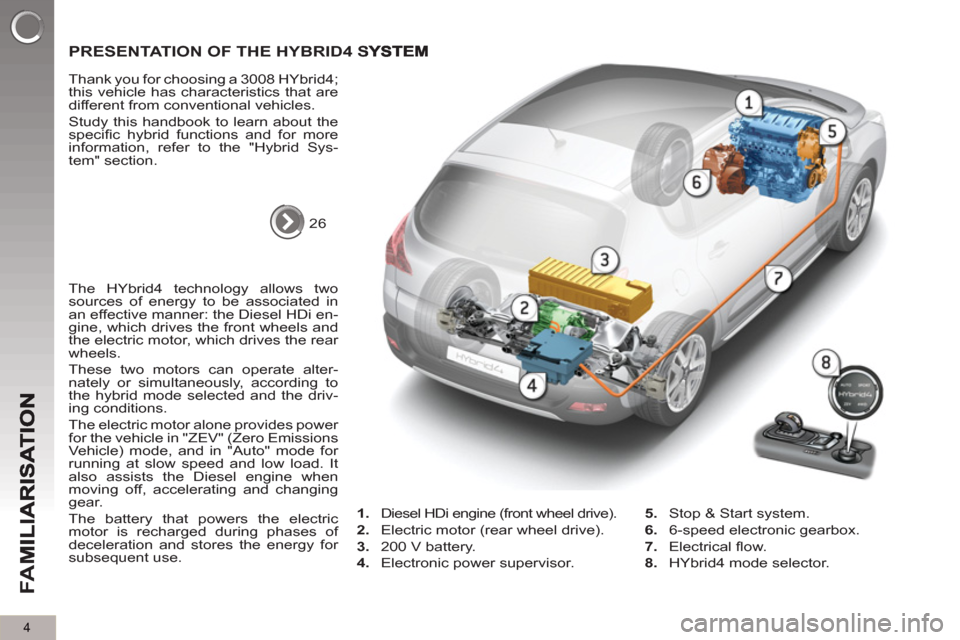
4
FA
M
PRESENTATION OF THE HYBRID4 SYSTEM
26
Thank you for choosing a 3008 HYbrid4;
this vehicle has characteristics that are
different from conventional vehicles.
Study this handbook to learn about the
specifi c hybrid functions and for more
information, refer to the "Hybrid Sys-
tem" section.
The HYbrid4 technology allows two
sources of energy to be associated in
an effective manner: the Diesel HDi en-
gine, which drives the front wheels and
the electric motor, which drives the rear
wheels.
These two motors can operate alter-
nately or simultaneously, according to
the hybrid mode selected and the driv-
ing conditions.
The electric motor alone provides power
for the vehicle in "ZEV" (Zero Emissions
Vehicle) mode, and in "Auto" mode for
running at slow speed and low load. It
also assists the Diesel engine when
moving off, accelerating and changing
gear.
The battery that powers the electric
motor is recharged during phases of
deceleration and stores the energy for
subsequent use.
1.
Diesel HDi engine (front wheel drive).
2.
Electric motor (rear wheel drive).
3.
200 V battery.
4.
Electronic power supervisor.
5.
Stop & Start system.
6.
6-speed electronic gearbox.
7.
Electrical fl ow.
8.
HYbrid4 mode selector.
Page 8 of 340
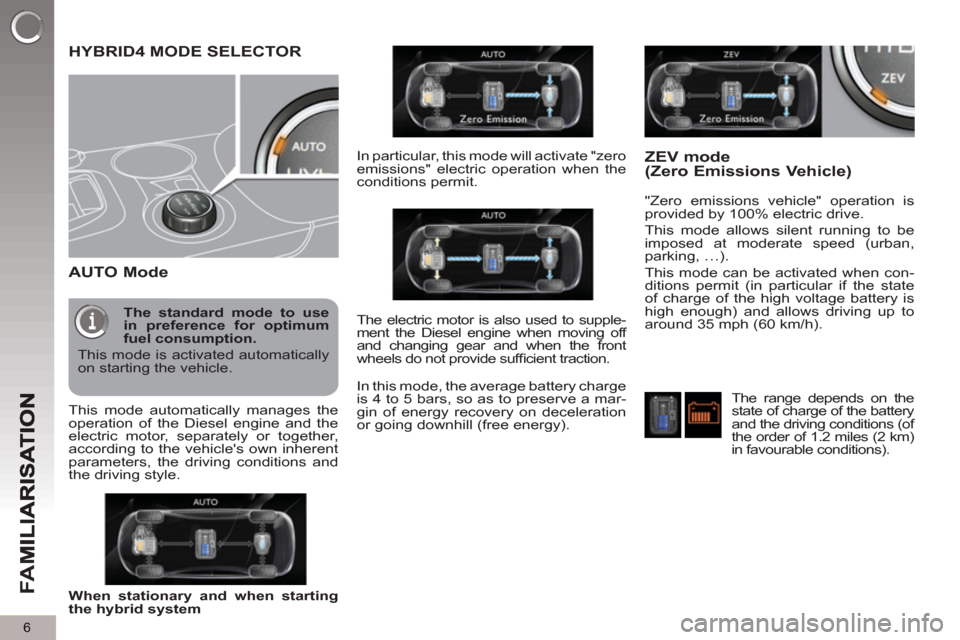
6
FA
M
HYBRID4 MODE SELECTOR
AUTO Mode
"Zero emissions vehicle" operation is
provided by 100% electric drive.
This mode allows silent running to be
imposed at moderate speed (urban,
parking, …).
This mode can be activated when con-
ditions permit (in particular if the state
of charge of the high voltage battery is
high enough) and allows driving up to
around 35 mph (60 km/h).
ZEV mode(Zero Emissions Vehicle)
When stationary and when starting
the hybrid system
This mode automatically manages the
operation of the Diesel engine and the
electric motor, separately or together,
according to the vehicle's own inherent
parameters, the driving conditions and
the driving style.
The standard mode to use
in preference for optimum
fuel consumption.
This mode is activated automatically
on starting the vehicle.
In particular, this mode will activate "zero
emissions" electric operation when the
conditions permit.
The electric motor is also used to supple-
ment the Diesel engine when moving off
and changing gear and when the front
wheels do not provide suffi cient traction.
The range depends on the
state of charge of the battery
and the driving conditions (of
the order of 1.2 miles (2 km)
in favourable conditions).
In this mode, the average battery charge
is 4 to 5 bars, so as to preserve a mar-
gin of energy recovery on deceleration
or going downhill (free energy).
Page 9 of 340
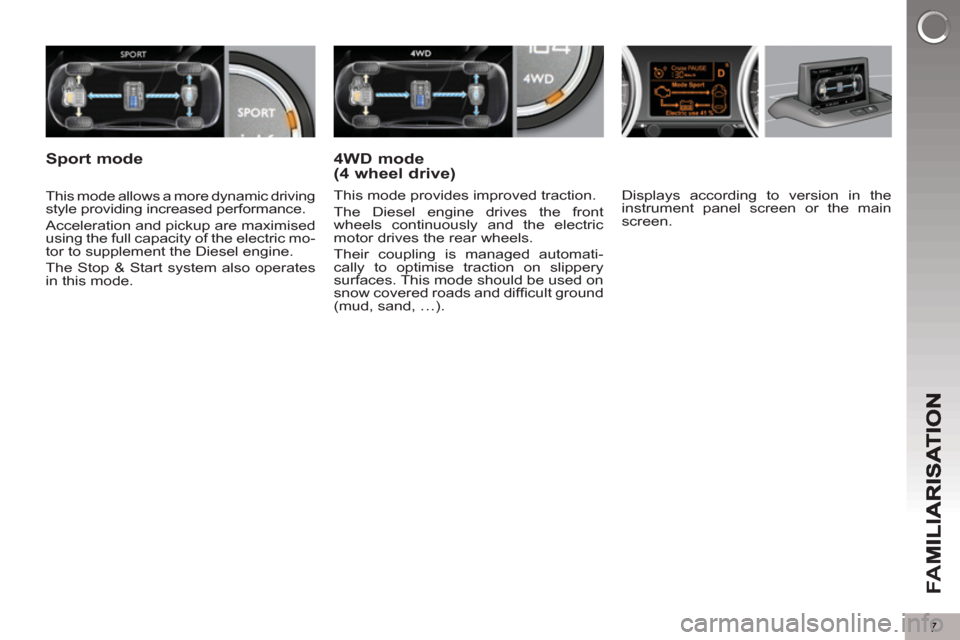
7
FA
M
Displays according to version in the
instrument panel screen or the main
screen.
This mode allows a more dynamic driving
style providing increased performance.
Acceleration and pickup are maximised
using the full capacity of the electric mo-
tor to supplement the Diesel engine.
The Stop & Start system also operates
in this mode.
This mode provides improved traction.
The Diesel engine drives the front
wheels continuously and the electric
motor drives the rear wheels.
Their coupling is managed automati-
cally to optimise traction on slippery
surfaces. This mode should be used on
snow covered roads and diffi cult ground
(mud, sand, …).
Sport mode
4WD mode (4 wheel drive)
Page 10 of 340
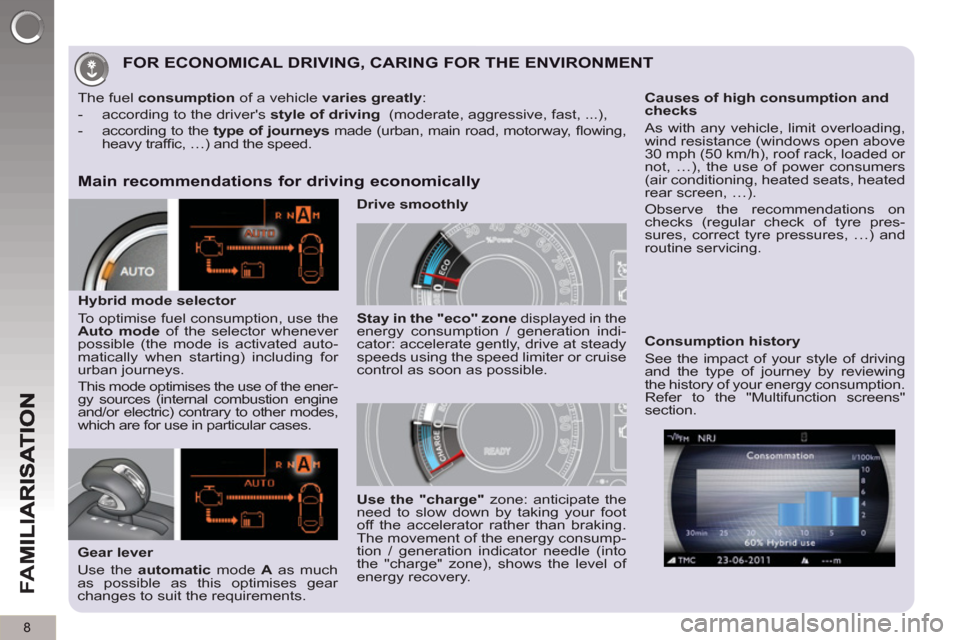
8
FA
M
FOR ECONOMICAL DRIVING, CARING FOR THE ENVIRONMENT
Main recommendations for driving economically
Gear lever
Use the automatic
mode A
as much
as possible as this optimises gear
changes to suit the requirements.
The fuel consumption
of a vehicle varies greatly
:
- according to the driver's style of driving
(moderate, aggressive, fast, ...),
- according to the type of journeys
made (urban, main road, motorway, fl owing,
heavy traffi c, …) and the speed.
Hybrid mode selector
To optimise fuel consumption, use the
Auto
mode
of the selector whenever
possible (the mode is activated auto-
matically when starting) including for
urban journeys.
This mode optimises the use of the ener-
gy sources (internal combustion engine
and/or electric) contrary to other modes,
which are for use in particular cases.
Stay in the "eco" zone
displayed in the
energy consumption / generation indi-
cator: accelerate gently, drive at steady
speeds using the speed limiter or cruise
control as soon as possible.
Causes of high consumption and
checks
As with any vehicle, limit overloading,
wind resistance (windows open above
30 mph (50 km/h), roof rack, loaded or
not, …), the use of power consumers
(air conditioning, heated seats, heated
rear screen, …).
Observe the recommendations on
checks (regular check of tyre pres-
sures, correct tyre pressures, …) and
routine servicing.
Consumption history
See the impact of your style of driving
and the type of journey by reviewing
the history of your energy consumption.
Refer to the "Multifunction screens"
section.
Use the "charge"
zone: anticipate the
need to slow down by taking your foot
off the accelerator rather than braking.
The movement of the energy consump-
tion / generation indicator needle (into
the "charge" zone), shows the level of
energy recovery.
Drive smoothly
Page 28 of 340
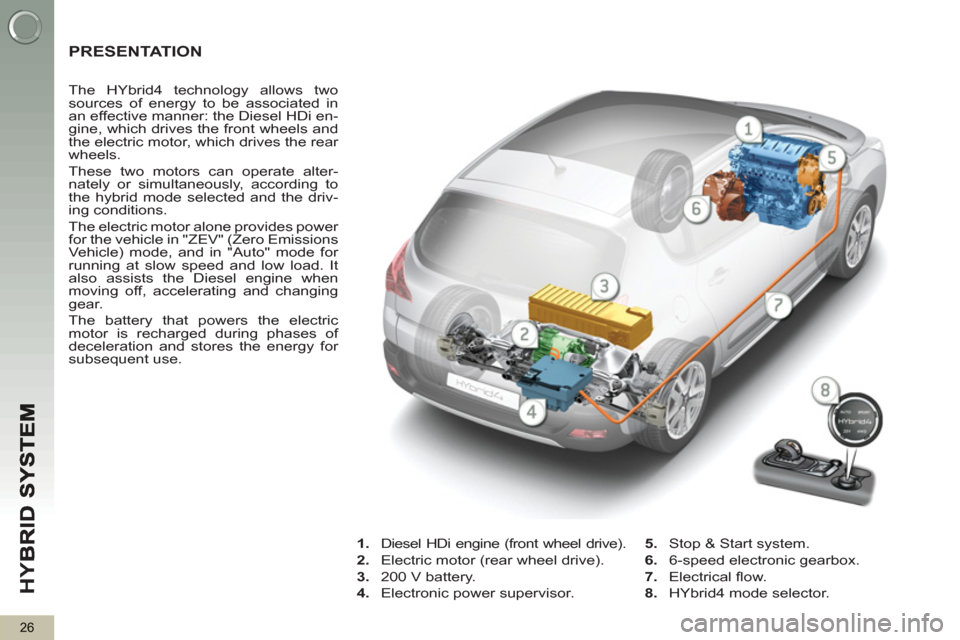
HY
B
26
PRESENTATION
The HYbrid4 technology allows two
sources of energy to be associated in
an effective manner: the Diesel HDi en-
gine, which drives the front wheels and
the electric motor, which drives the rear
wheels.
These two motors can operate alter-
nately or simultaneously, according to
the hybrid mode selected and the driv-
ing conditions.
The electric motor alone provides power
for the vehicle in "ZEV" (Zero Emissions
Vehicle) mode, and in "Auto" mode for
running at slow speed and low load. It
also assists the Diesel engine when
moving off, accelerating and changing
gear.
The battery that powers the electric
motor is recharged during phases of
deceleration and stores the energy for
subsequent use.
1.
Diesel HDi engine (front wheel drive).
2.
Electric motor (rear wheel drive).
3.
200 V battery.
4.
Electronic power supervisor.
5.
Stop & Start system.
6.
6-speed electronic gearbox.
7.
Electrical fl ow.
8.
HYbrid4 mode selector.
Page 29 of 340

27
Main parts of the HYbrid4 system
The HDi Diesel engine - 1
, located at the front, drives the front wheels and pro-
vides most of the power needed to drive the vehicle.
It is fi tted with the Stop & Start
system - 5
which recharges the batteries and pro-
vides additional power when needed (in 4x4 mode).
The electric motor - 2
, located at the rear, drives the rear wheels on its own, or
supplements the Diesel engine, according to the hybrid mode selected.
It recovers energy and charges the batteries during phases of deceleration of the
vehicle and is active up to 70 mph (120 km/h).
A 200 V NI-MH high voltage battery - 3
, provides a source of energy for the rear
electric motor.
Its charging rate is managed automatically by the vehicle during phases of decel-
eration.
It is located in a compartment in the boot, access to which is restricted to trained
service technicians.
The battery state of charge
is indicated by 8 horizontal or vertical bars (depending
on the screen).
The conventional battery
, located under the bonnet, powers the vehicle's 12 V
systems. It is recharged automatically by the high voltage network.
Page 30 of 340
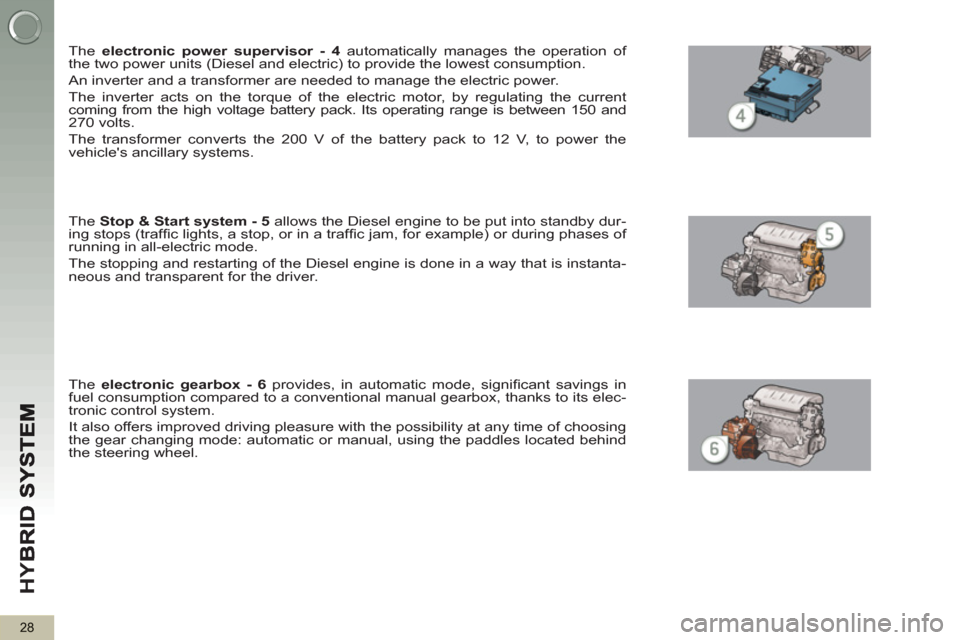
HY
B
28
The electronic power supervisor - 4
automatically manages the operation of
the two power units (Diesel and electric) to provide the lowest consumption.
An inverter and a transformer are needed to manage the electric power.
The inverter acts on the torque of the electric motor, by regulating the current
coming from the high voltage battery pack. Its operating range is between 150 and
270 volts.
The transformer converts the 200 V of the battery pack to 12 V, to power the
vehicle's ancillary systems.
The Stop & Start system - 5
allows the Diesel engine to be put into standby dur-
ing stops (traffi c lights, a stop, or in a traffi c jam, for example) or during phases of
running in all-electric mode.
The stopping and restarting of the Diesel engine is done in a way that is instanta-
neous and transparent for the driver.
The electronic gearbox - 6
provides, in automatic mode, signifi cant savings in
fuel consumption compared to a conventional manual gearbox, thanks to its elec-
tronic control system.
It also offers improved driving pleasure with the possibility at any time of choosing
the gear changing mode: automatic or manual, using the paddles located behind
the steering wheel.
Page 34 of 340
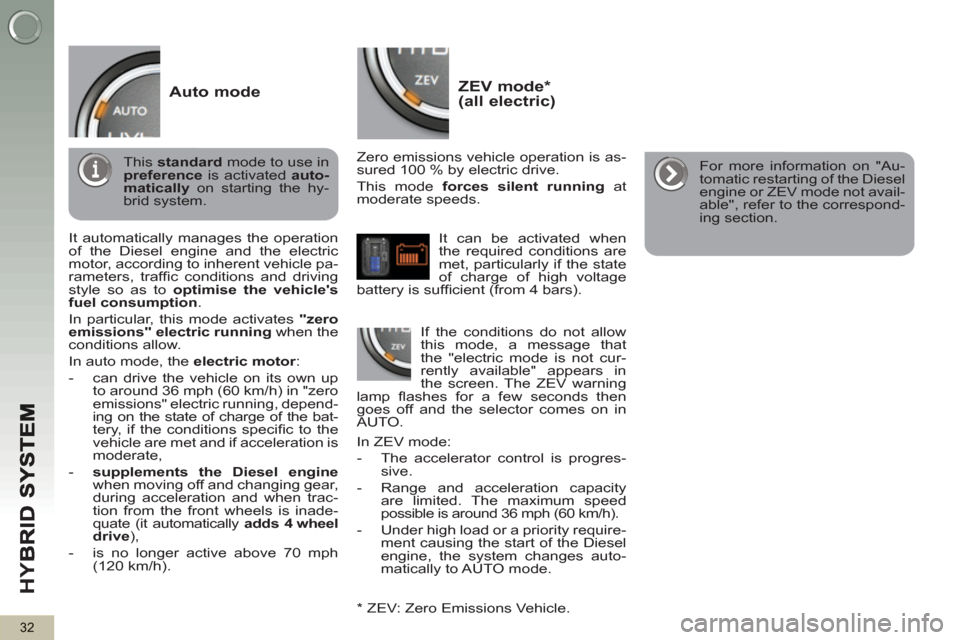
HY
B
32
ZEV mode * (all electric)
Zero emissions vehicle operation is as-
sured 100 % by electric drive.
This mode forces silent running
at
moderate speeds.
* ZEV: Zero Emissions Vehicle. In ZEV mode:
- The accelerator control is progres-
sive.
- Range and acceleration capacity
are limited. The maximum speed
possible is around 36 mph (60 km/h).
- Under high load or a priority require-
ment causing the start of the Diesel
engine, the system changes auto-
matically to AUTO mode.
It can be activated when
the required conditions are
met, particularly if the state
of charge of high voltage
battery is suffi cient (from 4 bars).
If the conditions do not allow
this mode, a message that
the "electric mode is not cur-
rently available" appears in
the screen. The ZEV warning
lamp fl ashes for a few seconds then
goes off and the selector comes on in
AUTO.
Auto mode
It automatically manages the operation
of the Diesel engine and the electric
motor, according to inherent vehicle pa-
rameters, traffi c conditions and driving
style so as to optimise the vehicle's
fuel consumption
.
In particular, this mode activates "zero
emissions" electric running
when the
conditions allow.
In auto mode, the electric motor
:
- can drive the vehicle on its own up
to around 36 mph (60 km/h) in "zero
emissions" electric running, depend-
ing on the state of charge of the bat-
tery, if the conditions specifi c to the
vehicle are met and if acceleration is
moderate,
- supplements the Diesel engine
when moving off and changing gear,
during acceleration and when trac-
tion from the front wheels is inade-
quate (it automatically adds
4 wheel
drive
),
- is no longer active above 70 mph
(120 km/h).
This standard
mode to use in
preference
is activated auto-
matically
on starting the hy-
brid system.
For more information on "Au-
tomatic restarting of the Diesel
engine or ZEV mode not avail-
able", refer to the correspond-
ing section.
Page 35 of 340
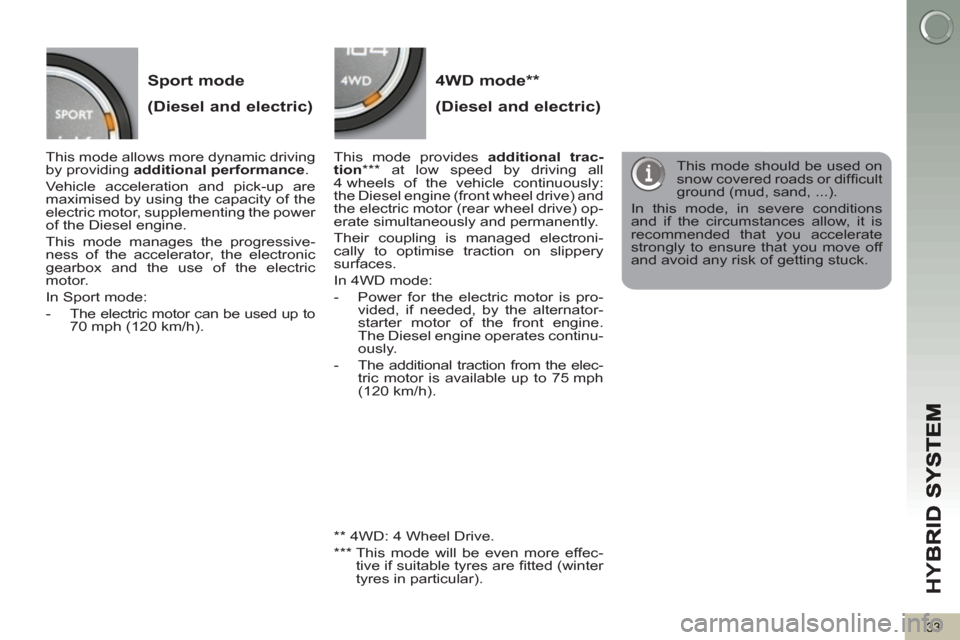
HY
B
33
Sport mode
(Diesel and electric)
4WD mode **
(Diesel and electric)
This mode allows more dynamic driving
by providing additional performance
.
Vehicle acceleration and pick-up are
maximised by using the capacity of the
electric motor, supplementing the power
of the Diesel engine.
This mode manages the progressive-
ness of the accelerator, the electronic
gearbox and the use of the electric
motor.
In Sport mode:
- The electric motor can be used up to
70 mph (120 km/h).
This mode provides additional trac-
tion
*** at low speed by driving all
4 wheels of the vehicle continuously:
the Diesel engine (front wheel drive) and
the electric motor (rear wheel drive) op-
erate simultaneously and permanently.
Their coupling is managed electroni-
cally to optimise traction on slippery
surfaces.
In 4WD mode:
- Power for the electric motor is pro-
vided, if needed, by the alternator-
starter motor of the front engine.
The Diesel engine operates continu-
ously.
- The additional traction from the elec-
tric motor is available up to 75 mph
(120 km/h).
This mode should be used on
snow covered roads or diffi cult
ground (mud, sand, ...).
In this mode, in severe conditions
and if the circumstances allow, it is
recommended that you accelerate
strongly to ensure that you move off
and avoid any risk of getting stuck.
**
4WD: 4 Wheel Drive.
***
This mode will be even more effec-
tive if suitable tyres are fi tted (winter
tyres in particular).